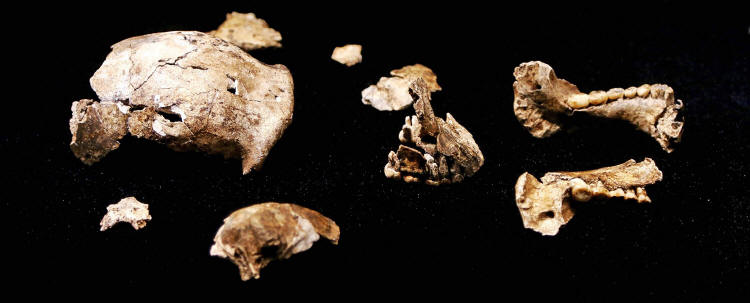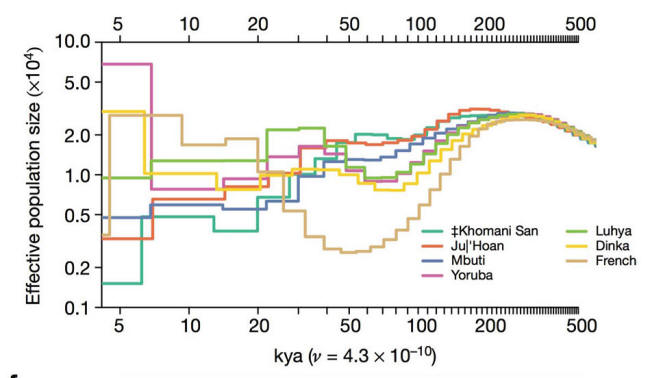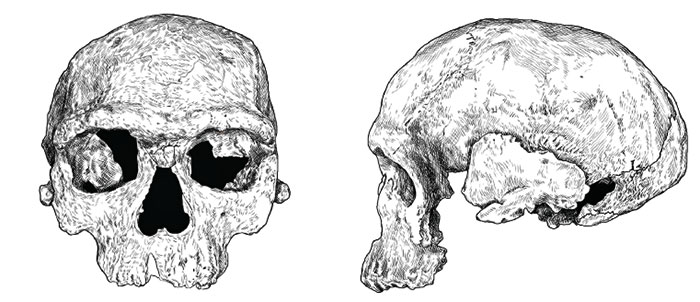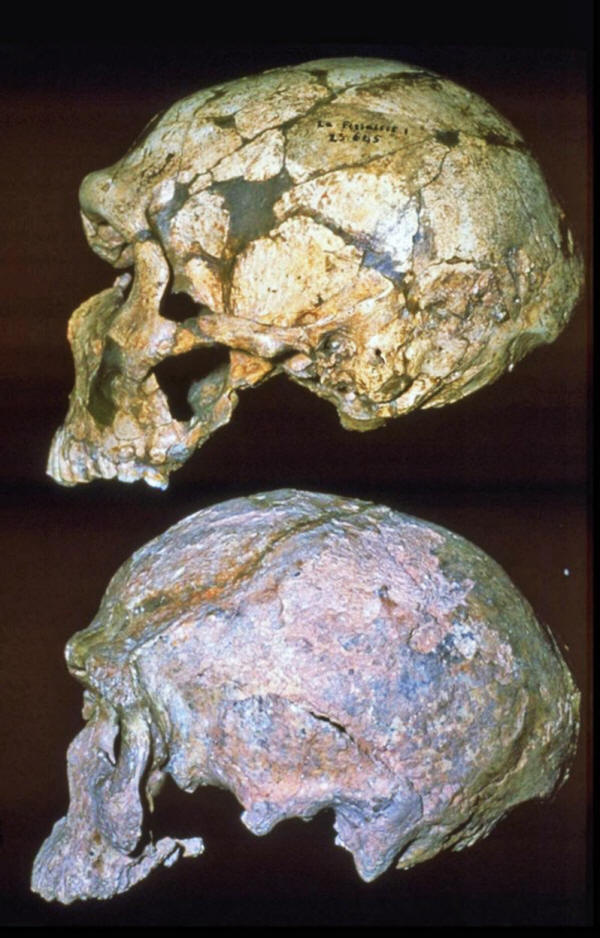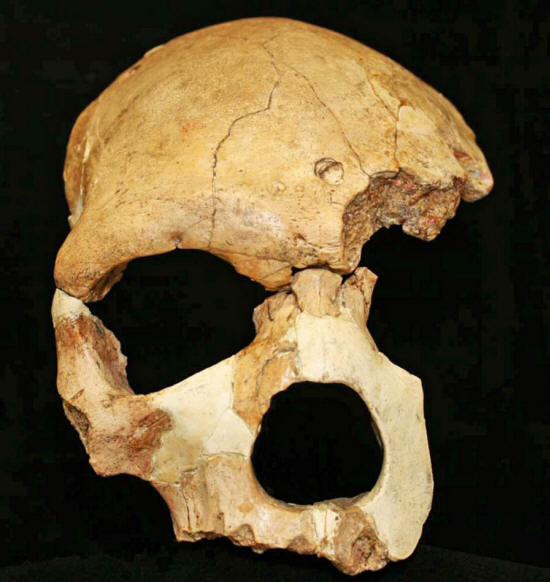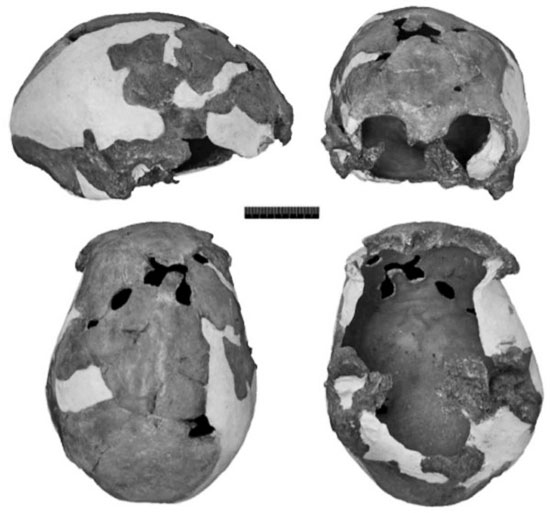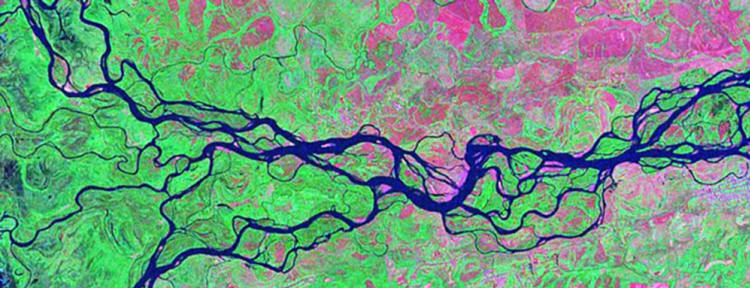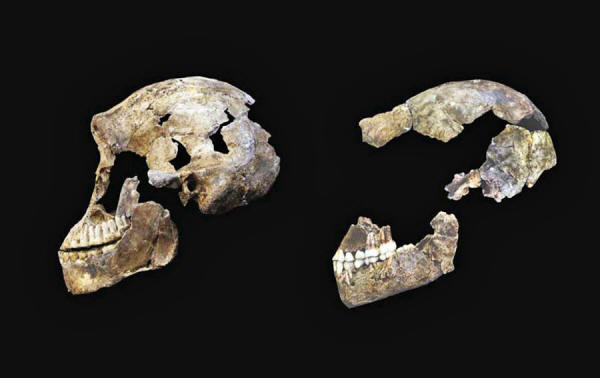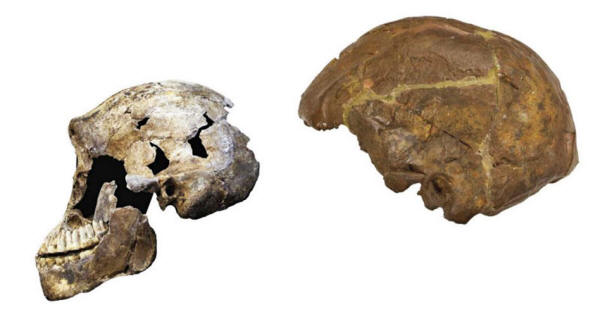|
from
Medium Website
"Neo" skull of Homo naledi, on exhibit at Maropeng.
John Hawks CC-BY
The evolutionary story of modern humans
just got more
complicated...
Modern humans originated in Africa sometime around 200,000 years ago.
Some modern people spread
into other parts of the world sometime after 100,000 years ago,
mixing a bit with archaic human groups they met along the way.
They were far from alone:
The last month has seen more shake-ups to the modern human origins story than any time I can remember.
Here's what we have learned in the last few weeks about this key time period in Africa.
When geneticists first started measuring genetic differences between people, they realized that the population must have once been a lot smaller.
They came up with the
idea of a genetic "bottleneck", a period in which the human
population might have been very small.
from different populations (indicated). The French underwent a clear bottleneck, starting between 100,000 and 50,000 years ago, which was actually shared by all other people outside Africa. But the African populations here had no strong bottleneck. The Khoe-San people in this chart have no sign of a bottleneck at all. From Mallick et al., 2016,
They have inherited most of their genes from a small population that grew and dispersed throughout the world. That dispersal carried that signal of a "founder effect" along with it. Those people further mixed a small fraction with archaic humans, the Neanderthals, and for a few, the Denisovans.
That founder effect
unfolded within the last 100,000 years.
Until this week, geneticists have thought that their ancestral lineage has existed for as long as 200,000 years. That origin, the deepest split between human populations that still exist, points to the stem population of all living people.
It doesn't divide
Africans from non-Africans, it reflects a deep history of diversity
among African populations - the founder effect leading to
non-African peoples was much later.
But there's an important
difference. By comparing his genome with the genes of living people,
Schlebusch and her coworkers found that today's Khoe-San have
received a lot of genetic mixture from other populations during the
last 2000 years.
Humans mix with each
other, and that mixture has increased in recent times. Very ancient
peoples mixed too, but migration and mixing were less in the distant
past than in recent history.
If we use today's genetic
diversity to try to work out the original ancestors of modern
humans, we're going to come up with an answer that is too recent,
because of these recently shared genes.
The answer was a lot
older, around 260,000 years ago. Modern populations, the
ancestors of living people, have been diversifying from each other
within Africa for at least that long.
So when we look back into the past, we are looking at populations that reticulated with each other.
But anthropologists really disagree about how to identify "modern humans" in the fossil record. A fossil that shares some human traits might be part of that delta network leading to some living populations.
But just as easily, it
might instead be off on its own branch, flowing until it disappears
into the desert sands.
So how can we recognize
them? And how many groups of them were there?
Old excavations carried out in the 1960s had produced parts of three skulls and some other human bones. Previous scholars had tried to work out the geological age of these remains, ultimately deciding they were around 150,000 years old.
Credit:
John Hawks CC-BY
These fossils and the
archaeological layer they come from are somewhere between 220,000
and 380,000 years old. That overlaps with the time
range of the first modern humans.
Do these fossils fit into the origin of modern humans somehow? Anthropologists are unanimous that the braincases of the Jebel Irhoud skulls don't look much like modern humans. They are elongated, with an angled cranial rear.
They aren't Neanderthals, but it would be a big stretch to connect them to living people.
compared to Jebel Irhoud 1 skull (bottom). The face of Jebel Irhoud is shorter than the Neanderthal, but it has a clear and continuous browridge, and its braincase is not very much like modern humans.
Photo
courtesy of Milford Wolpoff.
The faces of Jebel Irhoud 1, and the newly-discovered Jebel Irhoud 10, are a bit shorter, with cheeks are shaped more like modern humans than like Neanderthals.
The brows of Jebel
Irhoud 2 are reduced, like robust modern humans in their form,
although Jebel Irhoud 1 has a stout and continuous browridge.
The jaws from the site are robust and have big teeth, but they are
taller in the front than in the back, and the midline of the
jawbones are vertical.
The jaws lack that most
modern mandibular feature, the chin. Many of the humanlike aspects
of the face can also be found in some much older fossil remains,
such as the Homo antecessor fossils from Spain.
The paper describing this idea mentions another old fossil with a combination of archaic and modern features, a partial skull from Florisbad, South Africa, also clearly not modern human, but with a few humanlike features.
might be in this time range, but the date depends on a tooth that
may not
be the same context or individual.
They connect the
evolution of these early Homo sapiens people to a new form of
technology, the
Middle Stone Age, which was found
in various regions of Africa by 300,000 years ago.
Under the Hublin model,
there may have been none. Every fossil sharing some modern
human traits may have a place within the "pan-African" evolutionary
pattern. These were not river channels flowing into the desert,
every channel was part of the mainstream.
Geneticists think there were others...
The 2000-year-old Ballito Bay boy is not the oldest, but there are no DNA results from truly archaic specimens, like the Kabwe skull from Zambia.
As a result, we don't have the kind of record within Africa that geneticists have built for Neanderthals and Denisovans in Eurasia. But a series of genetic studies on living Africans have succeeded in identifying signs of mixture from ancient people.
This work, led by Michael Hammer, Jeff Wall, Joe Lachance, and others, is built upon a close examination of the genomes from living people.
What they are finding is
genetic ghosts...
Using those clues,
researchers are now able to identify "ghost populations", ancient
groups whose mixture with modern humans helps to explain some
aspects of diversity in African genomes today.
They were ancient
lineages with long histories, starting from long before any modern
humans existed, and they were mixing with modern populations as
recently as 20,000 years ago.
Skull from Iwo Eleru, Nigeria. Photo credit: Katerina Harvati and colleagues
CC-BY
Some anthropologists have
suggested possible candidates. One archaic-looking human skull,
found from Iwo Eleru, Nigeria, even existed during this latest part
of the Pleistocene when the last signs of mixture have been
identified.
But the river leading to
that delta was not one big channel; it was a braided series of
streams.
That dominant stream, that special population of human ancestors, lived sometime before 260,000 years ago.
Jebel Irhoud might have been on the mainstream, or it might have been part of one of the more minor contributing archaic groups, making up a percent or two of the genomes of living people.
Or it might belong to
a still more distant extinct branch, its facial features
inherited from very ancient ancestors like Homo antecessor and
marking no special relationship with any modern humans.
They cannot answer this question because they cover such a tiny fraction of the African continent...
"Neo" skull (left) compared to DH1 skull of Homo naledi (right).
Photo credit: John Hawks CC-BY
Last month, our team
published the first scientific assessment of the age of this new
species, between 236,000 and 335,000 years old.
It lived during the time that hominins were making Acheulean handaxes, and it lived as Middle Stone Age techniques began to proliferate in southern Africa.
We cannot assume that H. naledi wasn't the species that made these tools where it lived. We don't know what the interactions between H. naledi and other populations may have been.
The fossil record isn't good enough to say whether they existed in the same place as any other modern or archaic humans.
Omo 2 skull usually attributed to modern humans (right).
Photo
credit: John Hawks CC-BY
Many of the important fossils, like the Florisbad skull, and the Kabwe skull from Zambia, were recovered at a time when fossil contexts were not recorded with the level of precision as today.
Methods of direct dating such fossils have improved, but each advance means that old dates may not be trustworthy.
That is, after all, why we are talking about new dates for Jebel Irhoud right now.
The answer is to make
more discoveries...
One thing that H. naledi
reminds us is that the development of technology is a broader issue
than the origin of modern humans.
The answers to these
questions are not simple. Our evolution may have encompassed many
parts of Africa, but it certainly was not uniform, and right now it
looks like the subequatorial part of the story was especially
complex and interesting.
That's the way that we
will start to solve these new problems and shed light on old
mysteries...
|


